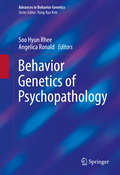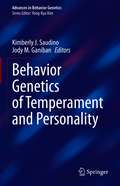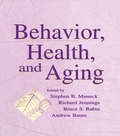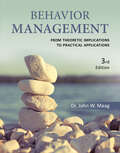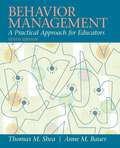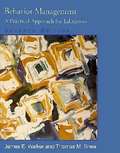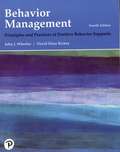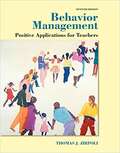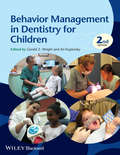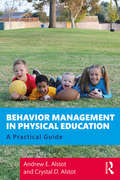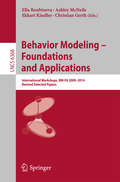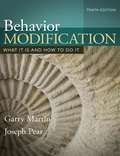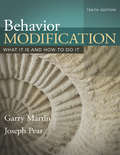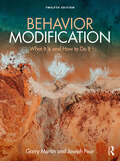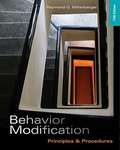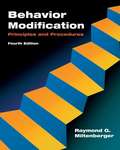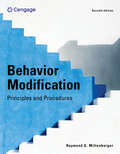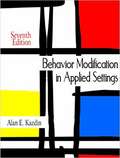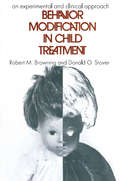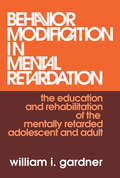- Table View
- List View
Behavior Genetics of Psychopathology (Advances in Behavior Genetics #2)
by Soo Hyun Rhee Angelica RonaldAs a dynamic, interdisciplinary field, behavior genetics and its evolution are being followed closely by scientists across the psychological and medical domains. The discoveries surrounding the human genome and the advancement in molecular genetic technologies have led to studies becoming increasingly sophisticated and yielding yet more conclusive and useful results. This is certainly the case in the area of child and adult psychopathology. Behavior Genetics of Psychopathology summarizes the state of the field, examining the role of genes and environment as they affect common neurodevelopmental and psychiatric conditions. Emphasizing key research areas (comorbidities, twin studies, the integration of methods), the book assesses the current literature, offers up-to-date findings, sorts through lingering controversies, and identifies a clear future agenda for the field. Expertly-written chapters focus on issues of both general salience that shape behavior genetics of psychopathology, to specific disorders of major clinical importance, among them: ADHD: the view from quantitative genetic research. Autism spectrum disorders and their complex heterogeneity Genetic influences on anxiety and depression in childhood and adolescence. Evidence for etiologically-defined subgroups within the construct of antisocial behavior. Sleep and psychopathology: the reasons for their co-occurrence. Behavioral genetic approaches to the etiology of comorbidity. Epigenetics of psychopathology. This combination of timeliness and depth of coverage make Behavior Genetics of Psychopathology a frontline resource for behavior geneticists, psychologists, psychiatrists, and neuroscientists, and is perfectly suited to graduate students looking to join these fields.
Behavior Genetics of Temperament and Personality (Advances in Behavior Genetics)
by Kimberly J. Saudino Jody M. GanibanThis volume examines behavioral genetic research on temperament and personality from a number of perspectives. It takes a developmental perspective on a number of issues across the lifespan, focusing on personality and temperament. The first section focuses on the development of temperament and personality. Typically this has involved exploring genetic and environmental contributions to phenotypic stability and instability, but more recently there has been research that examines the etiology of intra-individual change/growth trajectories. The second section examines genetic and environmental contributions to the association between temperament and personality and other behaviors. The third and fourth sections discuss genotype-environment correlations and interactions, and introduces the reader to molecular genetics research on temperament and personality. Chapter 11 will discuss the significance of this type of research and Chapter 12 will provide an example of specific line of research exploring genes associated with temperament.
Behavior, Health, and Aging (Perspectives on Behavioral Medicine Series)
by Andrew Baum Stephen B. Manuck Richard Jennings Bruce S. RabinA dramatic shift in the average age of the U.S. population and the increasing number of elderly Americans has introduced new and challenging healthcare dilemmas. This book addresses these issues with contributed chapters by the leading authorities in the field of behavioral medicine. It deals with health and healthcare needs of the elderly by considering basic changes that result from aging and some of the more specific problems that accompany it. Content highlights include a review of the basic tenets of genetics and molecular biology including some of the methods of looking at heritable differences in health and well-being. Quality of life concerns are addressed, including the differences between men and women, as well as other gender issues. Several chapters deal with the effects of aging on immunity. The latter part of the book emphasizes the psychosocial implications of aging on cardiovascular disease. Chronic illness among the elderly is also addressed.
Behavior in Foreign Languages: Experimental Evidence on Creativity, Cooperation, and Culture-Related Effects (Innovation und Entrepreneurship)
by Stefan NothelferWorking and interacting in foreign languages is widespread. While the relationship between language and behavior has been discussed for many years, empirical evidence for behavioral effects of foreign language use is surprisingly scarce. Stefan Nothelfer has conducted a series of laboratory studies to investigate and disentangle effects of language and culture on creativity and cooperation, important behavioral foundations of innovation. He draws insights from a large cross-country dataset with pairings between three languages, using a custom-built mobile laboratory. The author’s findings challenge theories of linguistic relativity, foreign language effects, and cultural accommodation, and enrich the empirical basis for fundamental research on language and behavior.
Behavior in Public Places
by Erving GoffmanErving Goffman effectively extends his argument in favor of a diagnosis of deviant behavior which takes account of the whole social situation.
Behavior Intervention Manual
by Samm N. HouseOutlines goals, objectives and intervention strategies to be used in educational settings, for 253 behaviors grouped by categories.
Behavior Management: From Theoretical Implications to Practical Applications
by John W. MaagBehavior management isn't about providing students with stickers when they exhibit appropriate behaviors -- it entails much more. Authored by nationally recognized scholar and behavioral consultant Dr. John W. Maag, this book focuses primarily on students' observable behaviors and the environmental factors that affect their expression. As Maag points out, behavior management is probably one of the most misunderstood concepts in education. Written in an accessible style, this book demystifies stereotypical beliefs and misconceptions regarding the use of reinforcement, punishment, and self-control. Maag offers clear, yet detailed descriptions of proven intervention techniques, supplemented by step-by-step guidelines, real-life examples, sample forms, and visuals that assist you in implementing these techniques in the classroom. Although the techniques described are based on a sound theoretical and empirical foundation, the author limits the use of technical jargon.
Behavior Management: A Practical Approach For Educators
by Thomas Shea Anne BauerLong an established and popular text in its field, Behavior Management: A Practical Approach for Educators successfully balances theory and practice to provide readers with a comprehensive manual for creating a positive, pro-social educational environment in which all children can truly learn and enjoy that learning experience. By presenting both research and the proven practices that developed from that research, the authors are able to fully explain behavior management from four perspectives—behavioral, psychodynamic, biophysical, and environmental—in straightforward, jargon-free prose. At the same time, real-life case studies, classroom techniques, clear examples, and helpful plan designs allow preservice and inservice teachers to easily bring what they have learned into the classroom. The new tenth edition has been revised and rewritten to improve its usability and readability, and includes evidence based practices that have recently been identified. A new chapter on response-to-intervention, and its relationship to functional behavioral assessment has also been added, as well as updated information on designing individualized behavior plans.
Behavior Management: A Practical Approach for Educators
by James E. Walker Thomas M. SheaChild psychology textbook aimed at teachers.
Behavior Management: Principles and Practices of Positive Behavioral Interventions and Supports
by John Wheeler David Dean RicheyThis book provides readers with a thorough overview of behavior analysis and PBIS theory and applications. Using vignettes and student examples, the book shows teachers how to achieve optimal behavioral and learning outcomes for their students–regardless of the challenging behavior exhibited. Chapters address universal tools such as reinforcement, meaningful instruction, and student progress monitoring. Behavior support plans demonstrate how to implement techniques for students at all levels and abilities across learning environments. Referencing the latest research in the field, the 4th Edition expands its coverage of prevention, schoolwide PBIS, and student progress monitoring.
Behavior Management: Positive Applications for Teachers
by Thomas J. ZirpoliHere are numerous school-wide and individual strategies for measuring, assessment, and dealing effectively with behavior challenges in today’s regular and special education classrooms. Ideal for classroom management or behavior management courses with an emphasis on school-based environments, Zirpoli’s Behavior Management is research based while focusing on the practical aspects of the behavior challenges educators commonly face. Included are functional applications and examples, including Classroom Connections and reflections on these connections; discussion questions; a number of embedded, meaningful examples for teachers and other caregivers; and related Internet links. The Enhanced Pearson eText features embedded video. Improve mastery and retention with the Enhanced Pearson eText* The Enhanced Pearson eText provides a rich, interactive learning environment designed to improve student mastery of content. The Enhanced Pearson eText is: Engaging. The new interactive, multimedia learning features were developed by the authors and other subject-matter experts to deepen and enrich the learning experience. Convenient. Enjoy instant online access from your computer or download the Pearson eText App to read on or offline on your iPad® and Android® tablet.* Affordable. Experience the advantages of the Enhanced Pearson eText along with all the benefits of print for 40% to 50% less than a print bound book. * The Enhanced eText features are only available in the Pearson eText format. They are not available in third-party eTexts or downloads. *The Pearson eText App is available on Google Play and in the App Store. It requires Android OS 3.1-4, a 7” or 10” tablet, or iPad iOS 5.0 or later.
Behavior Management in Dentistry for Children
by Ari Kupietzky Gerald Z. WrightGuiding patient behavior is as important as ever for the practicing dentist, and the behavior of pediatric patients is perhaps the most challenging to manage. Drs. Wright and Kupietzky here update Dr. Wright's classic work on managing pediatric dental patients.Behavior Management in Dentistry for Children,2nd Edition, has been entirely rewritten and includes the latest and most effective management strategies from an international team of experts in the field. The book addresses the influence of family and parenting styles on children's behavior and the factors that determine how children behave in the dental office. Pharmacological and non-pharmacological management techniques are described in depth, as are techniques for dealing with special needs patients. Clinical scenarios are described throughout the book, with practical application of the taught principles. The final part of the book covers the dental environment--training office personnel to manage children's behavior, practical considerations for behavior guidance, and the effects of the physical dental office environment.Behavior Management in Dentistry for Children,2nd Edition, is ideal for pediatric residents, dental students, and practicing dentists who see children on a regular basis.CD-ROM/DVD and other supplementary materials are not included as part of the e-book file, but are available for download after purchase.
Behavior Management in Physical Education: A Practical Guide
by Andrew E. Alstot Crystal D. AlstotBehavior Management in Physical Education provides evidence-based, practical guidance on behavior management in the physical education classroom. Readers will learn how to identify and define problem behavior, discover the reasons behind misbehavior, create thriving classrooms via the incorporation of positive and proactive classroom management strategies, implement procedures to address problem behavior, and collect appropriate data to ensure interventions are having a meaningful impact. The book includes discussion on the use of technology in the physical education classroom to aid the behavior management process, and features case studies in every chapter to highlight key concepts and practical tools to help teachers create a safe and enriching learning environment. This reader-friendly text will inspire aspiring and seasoned physical educators to try new techniques to strengthen their behavior management repertoire. It is an important read for preservice and in-service physical education teachers, as well as other physical activity practitioners, and a useful resource for students of physical education teaching methods and behavior management courses.
Behavior Modeling -- Foundations and Applications: International Workshops, BM-FA 2009-2014, Revised Selected Papers (Lecture Notes in Computer Science #6368)
by Ella Roubtsova Ashley Mcneile Ekkart Kindler Christian GerthThis book constitutes revised selected papers from the six International Workshops on Behavior Modelling - Foundations and Applications, BM-FA, which took place annually between 2009 and 2014. The 9 papers presented in this volume were carefully reviewed and selected from a total of 58 papers presented at these 6 workshops. The contributions were organized in topical sections named: modelling practices; new ways of behaviour modelling: events in modelling; and new ways of behaviour modelling: protocol modelling.
Behavior Modification: What It Is and How to Do It (10th Edition)
by Garry Martin Joseph PearBehavior Modification: What It Is and How to Do It, 10/e assumes no specific prior knowledge about psychology or behavior modification on the part of the reader. The authors begin with basic principles and procedures of behavior modification and then provide readers with how-to-skills such as observing and recording. Next, the authors provide advanced discussion and references to acquaint readers with some of the empirical and theoretical underpinnings of the field. Readers will emerge with a thorough understanding of behavior modification in a wide variety of populations and settings.
Behavior Modification: What It Is and How To Do It
by Garry Martin Joseph J. PearBehavior Modification,10/e assumes no specific prior knowledge about psychology or behavior modification on the part of the reader. The authors begin with basic principles and procedures of behavior modification and then provide readers with how-to-skills such as observing and recording. Next, the authors provide advanced discussion and references to acquaint readers with some of the empirical and theoretical underpinnings of the field. Readers will emerge with a thorough understanding of behavior modification in a wide variety of populations and settings.
Behavior Modification: What It Is and How To Do It
by Garry Martin Joseph J. PearBehavior Modification: What It Is and How to Do It is a comprehensive, practical presentation of the principles of behavior modification and guidelines for their application. Appropriate for university students and for the general reader, it teaches forms of behavior modification ranging from helping children learn necessary life skills to training pets, to solving personal behavior problems. It teaches practical "how-to" skills, including: discerning long-term effects; designing, implementing, and evaluating behavioral programs; interpreting behavioral episodes; observing and recording behaviors; and recognizing instances of reinforcement, extinction, and punishment. Behavior Modification is ideal for courses in Behavior Modification, Applied Behavior Analysis, Behavior Therapy, the Psychology of Learning, and related areas; and for students and practitioners of various helping professions (such as clinical psychology, counselling, education, medicine, nursing, occupational therapy, physiotherapy, psychiatric nursing, psychiatry, social work, speech therapy, and sport psychology) who are concerned directly with enhancing various forms of behavior development. The material is presented in an interesting, readable format that assumes no prior knowledge of behavior modification or psychology. Specific cases and examples clarify issues and make the principles real. Guidelines throughout provide a ready source to use as a reference in applying the principles.Online resources, including an instructor’s manual, are available at www.routledge.com/9780815366546.
Behavior Modification: What It Is and How To Do It
by Garry Martin Joseph J. PearBehavior Modification is a comprehensive, practical presentation of the principles of behavior modification and guidelines for their application. It introduces forms of behavior modification ranging from helping children learn necessary life skills, to training pets, to solving personal behavior problems. It teaches practical “how-to” skills, including discerning long-term effects; designing, implementing, and evaluating behavioral programs; interpreting behavioral episodes; observing and recording behaviors; and recognizing instances of reinforcement, extinction, and punishment. The material is presented in an engaging, readable format that assumes no prior knowledge of behavior modification or psychology. Specific cases and examples clarify issues and make the principles real. Guidelines throughout provide a ready source to use as a reference in applying the principles. Questions for Learning, an average of 25 per chapter, are included to support students in checking their knowledge of the material when preparing for tests and exams. Application Exercises are also included in most chapters to assist students in the development of the practical skills they will need to complete behavior modification projects effectively. Behavior Modification is ideal for courses in Behavior Modification, Applied Behavior Analysis, Behavior Therapy, the Psychology of Learning, and related areas; and for students and practitioners of various helping professions—such as clinical psychology, counselling, education, medicine, nursing, occupational therapy, physiotherapy, psychiatric nursing, psychiatry, social work, speech therapy, and sport psychology—who are concerned directly with enhancing various forms of behavior development.
Behavior Modification: Principles and Procedures (Fifth Edition)
by Raymond G. MiltenbergerThe book uses a precise, step-by-step, scientific approach to explain human behavior. The text is divided into 25 relatively short chapters, each of which covers a manageable amount of information. This text can be used in a standard one-semester course in behavior modification, applied behavior analysis, behavior management, or behavior change.
Behavior Modification: Principles and Procedures (4th edition)
by Raymond G. MiltenbergerUsing case studies to explain the scientific study of behavior modification, Miltenberger (psychology, North Dakota State U.) covers basic topics like the measurement of behavior, reinforcement, punishment, and stimulus control, as well as specific procedures for establishing new behavior, increasing desirable behavior, and decreasing undesirable behavior. The text is intended for sophomore level college students who need have no prior knowledge of the subject, as well as for individuals working in human services, education, or rehabilitation. Annotation (c)2003 Book News, Inc., Portland, OR (booknews.com)
Behavior Modification: Principles and Procedures
by Raymond G. MiltenbergerIntroduce the underlying principles and then the procedures behind behavior modification with Miltenberger's BEHAVIOR MODIFICATION: PRINCIPLES AND PROCEDURES, 7E. This precise, step-by-step approach clearly illustrates principles and procedures using numerous examples from current research, clinicals practice and everyday life. The author introduces the latest, practical information on the technologies used to measure and record behavior changes and implement assessment and intervention strategies. New content addresses verbal behavior and stimulus equivalence, while updated references highlight the latest research and developments from the field. This edition's new learning objectives direct the reader's attention to key material. Students can also use new self-assessment exercises, application and misapplication exercises, practice tests and three practice quizzes at the end of every chapter to ensure comprehension.
Behavior Modification in Applied Settings
by Alan E. KazdinContinuing the tradition of excellence established in previous editions, distinguished researcher, practitioner, and educator Alan Kazdin integrates pioneering and recent research with discussions and examples for altering behavior and the conditions that influence their effectiveness. he Seventh Edition reflects several developments within the field of behavior modification, without diminishing an essential emphasis on applied research and intervention techniques.
Behavior Modification in Child Treatment: An Experimental and Clinical Approach
by Robert M. BrowningThis book is the first attempt to validate behavior modification techniques in a carefully controlled experimental treatment environment for emotionally disturbed children. Such special settings permit carefully conducted research experiments can be carried out. This is the first book to synthesize scientific and clinical approaches to human behavior, indicating that behavior modification may one day be as much an applied science as engineering or medicine.This experimental approach introduces scientific rigor to the clinical setting, as evidenced by precise measurement of behavior variables, detailed specification of treatment procedures, and the use of sophisticated experimental designs to provide objective evaluation of the effectiveness of treatment programs. In this approach, series of idiographic (single-subject) case studies are conducted in a precise manner with each patient-subject admitted to the treatment program. The general research methodology is similar to that used in the broad area of operant conditioning, and most work reported in the book was conducted within a learning theory or behavior-modification framework.Browning and Stover discuss the general problems of developing and controlling a total therapeutic milieu, presenting practical discussions of problems of data collection, decisions about treatment programs to be used, staffing problems, and documental opinion on the relative values of various treatment techniques. Throughout attention is devoted to developing a method for answering common questions of parent, child-care worker, and professional. The authors conducted symposia on the material contained in this book at various national and regional meetings and have lectured extensively on college campuses. It is a ground-breaking study.
Behavior Modification in Mental Retardation: The Education and Rehabilitation of the Mentally Retarded Adolescent and Adult
by William GardnerIn this important book, one of the most exciting and promising developments in clinical psychology-behavior modification is applied to the treatment of the mentally retarded, particularly those whose behavior poses difficult problems for institutions. Professor Gardner presents an easily intelligible yet detailed account of the concepts and practices of behavior modification and the underlying learning systems, with numerous clinical illustrations of applying specific techniques to various educational and rehabilitation problems. A thorough discussion of the inadequacies of the psychological evaluation systems normally used in education and rehabilitation is offered, along with an alternative behavior analysis approach that provides a method of translating evaluation data into treatment practices. In explaining behavior analysis, the author takes into account the limited behavioral repertoire of the retarded and environmental deficits. Individual chapters on respondent, operant, and observational learning, and a detailed discussion of a functional analysis approach to evaluation, are included. Proven behavior modification strategies are presented along with a review of related research and clinical studies. The book closes with a detailed description of a research program for the design and testing of sheltered workshop systems for the retarded and emotionally disturbed. The positive approach inherent in the belief that behavior is modifiable-even in the severely limited retarded-is in marked contrast to the pessimism of other systems of therapy, education, and training. Also, the author has concentrated throughout on making the book understandable to clinicians and students with no previous knowledge of behavior modification. Besides serving as a valuable handbook for all treatment personnel, the book can also be used as a basic text for various courses dealing with mental retardation.
Behavior Modification: Principles and Procedures
by Raymond G. MiltenbergerThis text uses the principles of behavior modification to teach the procedures of behavior modification, illustrating them with key case studies and examples. Its precise, step-by-step approach includes practical information on the technologies used to measure and record behavior changes. BEHAVIOR MODIFICATION: PRINCIPLES AND PROCEDURES, Sixth Edition, also provides numerous opportunities for students to practice, including practice tests, application and misapplication exercises, and three quizzes at the end of every chapter.
